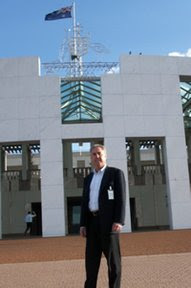Self-proclaimed economic conservative, Kevin Rudd, is economical with the truth in the explanation he gives for the global financial crisis. Rudd sanctimoniously gave his version of history in a speech last year:
Mortgage salespeople preyed on the aspirations of vulnerable families, soliciting them to take out home loans. Lenders confused working-class people, non-English-speaking families and first-time borrowers with hidden fees, ratchet interest rates and confusing repayment terms. Predatory financiers inflated borrowers' income and overstated their ability to pay back a loan.
These were the most obvious manifestations of the culture of greed and short-termism that pervaded large parts of the US financial sector. This culture was never challenged by a political and economic ideology of extreme capitalism. And this crisis bears the fingerprints of the extreme free-market ideologues who influence much of the neo-liberal economic elite, free-market ideologues who have a naive belief that unrestrained markets are always self-correcting and that markets left to themselves will always achieve optimum outcomes. Ideologues who believe that any regulation of private business is fundamentally wrong.
The truth is that it was misguided regulation rather than lack of regulation that was behind the lax lending standards which fuelled the housing bubble. The US government implemented a series of reforms that weakened lending standards with the aim of increasing home ownership among the poor and ethnic minorities. Lenders were compelled to give mortgages to borrowers on low incomes to satisfy regulations that were imposed by the Community Reinvestment Act (CRA). The government-sponsored enterprises (GSEs), namely Fannie Mae and Freddie Mac, had to meet "affordable housing goals" under the 1992 Federal Housing Enterprises Financial Safety and Soundness Act (FHEFSSA) by purchasing a certain percentage of mortgages for low and moderate income borrowers and those living in "underserved" areas.
Rudd's ideological posturing has not gone without criticism. Sinclair Davidson, Professor in the School of Economics, Finance and Marketing at RMIT and a Senior Fellow at the Institute of Public Affairs, gave his thoughts on Rudd's anti-capitalist remarks in an opinion piece that was published in The Advocate:
There really is nothing new under the sun. So too with the current financial crisis. But moralists are making hay while the sun shines. Prime Minister Kevin Rudd has blamed the financial crisis on 'extreme free market ideologues' who have 'resisted the regulation of financial markets.'
In contrast to what Kevin Rudd has argued it is a failure of regulatory capitalism. The causes of the current crisis are not 'greed and fear'; but rather the unintended consequences of do-gooders, bureaucratic intervention, and anti-capitalistic prejudice.
Rudd intends to continue with his campaign to ideologically indoctrinate Australians using the global financial crisis as an example of a failure of capitalism. While Australians are losing their jobs, Rudd has been writing a 7,000 word essay calling for greater government intervention in financial markets, even though he agrees that our financial system is among the most well regulated in the world.










